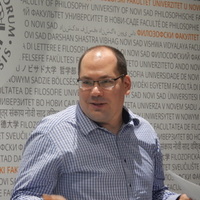Papers by Stefan Stojanovic
Opera Slavica, 33/4, 2023
This paper is concerned with the difficulties in the acquisition of the Russian participle system... more This paper is concerned with the difficulties in the acquisition of the Russian participle system by speakers of Serbian. The corpus for this analysis consists of the written examinations of the 3rd year students of Russian language, literature and culture at the Philological Faculty of the University of Belgrade. It was found that cross-linguistic influence plays a minor role, accounting for 12,65% of the total number of incorrect uses of Russian participles. Another 29,75% of the errors are those that are not due to cross-linguistic influence, but can be pointed out in class. Most of the errors (57,6%) are unmotivated, unpredictable errors, which are a consequence of the insufficient acquisition of the participial system as well as the overall poor knowledge of Russian grammar.
Opera Slavica 32 / 2022 / 4, 5-19, 2022
This paper represents a new attempt at determining the origin of the Proto-Slavic *soja ‘jay’. Gi... more This paper represents a new attempt at determining the origin of the Proto-Slavic *soja ‘jay’. Given the jay’s habit of sowing acorns and other large seeds, and, consequently, the abundance of words denoting jay originating from words meaning acorn, oak, nut in various European languages, in this paper a new h ypothesis on the origin of the Proto-Slavic name for jay has been postulated, namely of its origin from the verb *sěti/*sějati ‘to sow’. In this article, it was shown that the ablaut ě : oj required by such etymology could have been both inherited from the Proto-Indo-European language and appear by analogy with other similar pairs of verb : deverbal noun during the Proto-Slavic period.

Фактическая перфектность: примеры из русского и сербского языков. Rubio, Enrique Gutiérrez et al. (eds.): Contributions to the 22nd annual scientific conference of the Association of Slavists (Polyslav). Die Welt der Slaven. Sammelbände, band 65. Wiesbaden: Harrassowitz Verlag, 278-287, 2020
The aim of this paper is to provide evidence to include the meaning dubbed here factual perfect i... more The aim of this paper is to provide evidence to include the meaning dubbed here factual perfect into the perfect cluster. Factual perfect refers to action with little or no relevance, observed from the present. The lack of relevance connects this meaning with the preterit, whereas the reference point is the same as with the perfect. The data were collected using online corpora. The use of several Russian and Serbian verbal forms was analyzed: the Past tense (Russian), Perfect (Serbian), short Past passive participles (both languages), Aorist and Truncated perfect (Serbian). It was showed that factual perfect is different from preterit, as the Past tense / Perfect with factual perfect meaning normally cannot be replaced with forms specialized in expressing narrativity: the Historical present (both languages), Aorist and Truncated perfect (Serbian). The use of copulas with passive participles signals that factual perfect should be included into the perfect cluster, as in both languages both present and past copulas are possible, thus indicating the transitional character of this meaning.
Хачатрян, Г. и др. (ред.): V международная научная конференция "Язык и литература в контексте межкультурной коммуникации": материалы научной конференции. Ереван: Ванадзорский госуниверситет им. О. Туманяна, 2018

Јужнословенски филолог, књ. 74, св. 2, 2018
Настоящая статья является попыткой типологи ческой классификации сербского перфекта, то есть попы... more Настоящая статья является попыткой типологи ческой классификации сербского перфекта, то есть попыткой определить, в какой степени сербскому перфекту соответствует название перфект. У перфекта основным является перфектное значение, но сегодня его также можно использовать и в повествовании. Аорист и усеченный перфект тоже выражают перфектное значение, но данное значение для них не являе тся основным; им не присуща какая-либо определенная временная перспектива. Перфект выражает целую гамму перфектных значений, в то время как аорист и усеченный перфект являются более специализован-
ными формами, более ограниченными в выражении перфектной семантики. Мы определили перфект как расширенный неспециализированный перфект; аорист же и усеченный перфект мы определили как специализированный расширенный претерит и как специализированный расширенный перфект.
В настоящей статье исследуются типы результатов, типичные для отдельных разновидностей перфектнос... more В настоящей статье исследуются типы результатов, типичные для отдельных разновидностей перфектности и для результативности. В качестве примеров берутся страдательные причастия прошедшего времени и формы прошедшего времени. У результативного значения и квалификативной перфектности результат всегда непосредственный, и он всегда является состоянием. Для результативной перфектности обязательны посредственные эффекты, в то время как наличие непосредственного результата необязательно. Для экспериенциальной перфектности наиболее типичны посредственные эффекты. Количественную перфектность характеризуют непосредственные результаты, причем фокус на их количестве. Для континуативной перфектности результат, если и имеется, несуществен, так как фокус не на результате, а на продолжающейся ситуации.
В настоящей работе исследуется возможность у страдательных причастий на -н, -т выражать результат... more В настоящей работе исследуется возможность у страдательных причастий на -н, -т выражать результативное значение. Результативность является состоянием, возникшим в результате предшествующего действия. Результативное значение способны выразить лишь некоторые страдательные причастия – те, которые образованы от глаголов, обозначающих действия, непосредственным результатом которых является возникновение нового свойства, в частности изменение внешнего вида, психического состояния, положения тела, а также и доступ к объекту, открытость, закрытость, запрет, соединение объектов в пространстве.
Славитика 17. Београд: Славистичко друштво Србије, Филолошки факултет., 2013
Janyšková, I., H. Karlíková (eds.): Theory and Empiricism in Slavonic Diachronic Linguistics [Studia etymologica Brunensia 15], Praha: Lidové noviny, 235–242., 2012
This paper is a continuation of my study 7 e Homeland of Slavs in the light of names of some tree... more This paper is a continuation of my study 7 e Homeland of Slavs in the light of names of some trees and fi sh, published in 2010, in which I was able to strengthen the Middle Dnieper hypothesis, as well as to narrow the possible homeland of Slavs to the area along the Pripet River. � is paper presents further evidence coming from tree genera not discussed in the previous paper, namely elms, poplars and the aspen, and maples, showing that the homeland
of Slavs must have been situated along some river in the East European Plain, which agrees perfectly with my previous study. "
Fischer, K. B., G. Krumbholtz, M. Lazar, J. Rabiega-Wiśniewska (Hrsg.): Beiträge der Europäischen Linguistik (Polyslav) 13. München / Berlin, 238–244, 2010
Thesis Chapters by Stefan Stojanovic
Functional-semantic field of the perfect in Russian and Serbian languages










Uploads
Papers by Stefan Stojanovic
ными формами, более ограниченными в выражении перфектной семантики. Мы определили перфект как расширенный неспециализированный перфект; аорист же и усеченный перфект мы определили как специализированный расширенный претерит и как специализированный расширенный перфект.
of Slavs must have been situated along some river in the East European Plain, which agrees perfectly with my previous study. "
Thesis Chapters by Stefan Stojanovic
ными формами, более ограниченными в выражении перфектной семантики. Мы определили перфект как расширенный неспециализированный перфект; аорист же и усеченный перфект мы определили как специализированный расширенный претерит и как специализированный расширенный перфект.
of Slavs must have been situated along some river in the East European Plain, which agrees perfectly with my previous study. "